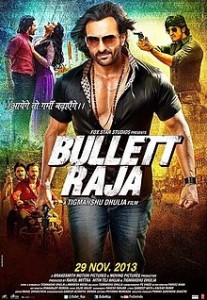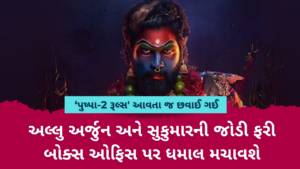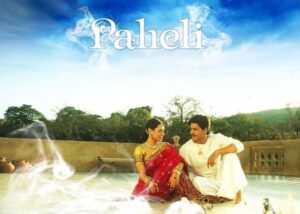Bullett Raja Review: Bullett Raja bites the dust, lacks the flavor, packs no punch. Conventional, clumsy and confused in every respect. Thigmanshu is certainly no Tarantino.
Rating: *
Bullett Raja expects a great deal from moviegoers. It expects us to be enraptured by its depiction of a violent, revenge-fuelled world. It expects us to look up to its hero as a legend. It wants us to laugh and cry and root for him. Its hero, Saif Ali Khan insists the film is almost ‘Tarantinoesque’; most movie-buffs know the name Quentin Tarantino as the cinematic illusionist (a director and writer with an absolutely distinctive style and treatment) behind works such as Pulp Fiction, Reservoir Dogs, The Kill Bill Series, The Inglorious Basterds and Django Unchained. This statement itself ups the audience expectations, and so does the film’s director Thigmanshu Dhulia’s resume, which includes critical and, in some cases, commercial hits like Paan Singh Tomar, Haasil, Sahib Biwi Aur Gangster and its sequel, Saahib Biwi Aur Gangster Returns. We enter the cinema halls wishing to see one of the best commercial films of the year. We exit forgetting each and every image that flashed before our eyes while sitting through Bullett Raja.
Here is a film that squanders all its potential strengths because it has no clue how it can be ‘commercial’ and yet
be ‘unconventional’. And when a film like Anurag Kashyap’s Gangs of Wasseypur, with a similar style of narrative and filming, has already achieved this feat, its shows that the audience listens and appreciates good, deep stuff when well told. Comparatively, Bullett Raja seems meh and old, and leaves you bored. It was really unwise of Khan to blurt out to the media about Tarantino. The reason: we start hunting for such moments. Tarantino is known to ‘state the same point in a roundabout fashion’, as Khan himself explained in an interview. Here’s an example: when Leonardo Di Caprio’s character in Django Unchained learns he’s about to be deceived by Christopher Waltz and Jamie Foxx, he doesn’t confront them by pulling his gun out and threatening to shoot if they act smart. Instead, he brings a skull of his former slave to the table and talks about what he would do to those who betrayed him by bashing the skull. His monologue continues for more than five minutes uninterrupted, and we listen. In Pulp Fiction, there’s talk on burgers, body piercing and even a ketchup joke – and yet we’re all ears.
And the hyper-violence – all the beheadings, eye gouging, mutilations, shotgun deaths we get in Kill Bill and Django Unchained – are captured with a delectable glee that makes them so much fun. And it’s not all style no substance; in fact, these scenes would’ve been meaningless had we not empathized with the film’s protagonists. We want the Bride from Kill Bill to get her revenge. We want Django to punish his despicable former masters. In retrospect, I have certain reservations about Pulp Fiction for its over-reliance on style and references to other films. On the other hand, my appreciation for Kill Bill and Django Unchained has grown over time.
Bullettt Raja seems fun and ‘Tarantinoesque’ at first. It’s amusing to watch arch rivals sitting together, one busy peeling mosambi skin as the other confronts him for attacking his men. There’s Chunkey Pandey’s character who loves telling stories about Lord Brahma. He’s shot down early in the film, but he says one final thing about Brahma which is apparently offensive. Too bad the prudes presiding the Central Board of Film Certification decide to mute it, so we don’t antagonize him as much as we would’ve had we heard the bloody line. A scene involves Jimmy Shergill and Saif Ali’s characters bumping off a slimy politician after entering his premises under the guise of interviewing him. We do laugh when Khan hands Shergill a scale because he wants to shoot the politician exactly from a distance of hundred feet. The leader also has gangaajal sprinkled on him before its Ram Naam Satya Hai for him.
The story isn’t anything new, and doesn’t try to be different. It’s about the rise of two good bad guys – Raja Mishra (Khan) and Rudra (Shergill) – in the world of dirty politics and mafia Raj in the state of Uttar Pradesh. Who are the ‘bad’ bad guys? There’s Lallan Tiwari (Pandey) and Akhandheer who kill their chacha. There’s Gulshan Grover’s character, a well-known industrialist who makes enemies with the protagonists after rebuking them at a meeting (usually held in the woods at night; you hear crickets chirping and wolves (?) howling). And then there’s Sumer Yadav (Ravi Kissen), a formidable sharpshooter who feigns madness by dressing up as Radha and dancing in temples only to escape from the cops. Vidyut Jamwal turns up later as a cop who breaks bones only to display his superb martial arts skills. A pooja usually takes place before these men get going with their guns. Sonakshi Sharma plays Saif’s Bengali love interest who enjoys serials, does a bit of drama, reveals her curvaceous figure in a bright red dress on the dance floor (why?) and… yeah, does her best to support the hero and stay out of the ‘real stuff’, because she’s a woman, right? There goes ‘gender equality in cinema’ out of the window!
The film misses out on so many opportunities along the way. It could’ve incorporated background music at certain points to a humorous or ironic effect; for example, when Grover’s character is kidnapped from his hotel room alongwith Sonakshi by the duo of Raja and Rudra, there’s a familiar hotel music playing in the background. In this situation, Dhulia could’ve used the music along with other elements such as the hotel staff to make the kidnapping more interesting. Instead, he cuts abruptly to the next scene. After Raja is compelled to temporarily flee alongwith Sonakshi to West Bengal to her parents’ home (where he has to deal with listless domestic problems), Sumer drops his guise and gains power in UP. The parallel (one’s bravado is threatened by family life while the other retains his) between the hero and the villain could’ve been highlighted with appropriate editing, but there’s hardly any effort made. Kissen’s character, given his interesting exposition, is largely underutilized. And why all the effort behind three utterly pointless songs?
Jimmy Shergill, a regular in Dhulia’s films, gets his part well. Khan seems out of place, like he’s a little too excited about playing a ‘dhamaakedaar action-wala UP ka bhaiyaa’ role after a long time. The end hints at a possible sequel (in which we may get to see more of Jamwal). You can count me out. I advice you spend this weekend catching some of Tarantino’s movies –that’s how movies are made. Bullettt Raja, on the other hand, bites the dust, lacking flavor and packing no punch. It’s conventional, clumsy and confused in every respect. Thigmanshu is certainly no Tarantino.
ourvadodara.in Rating Guide:
* = Avoid!!
** = Rent It / TV Premiere
*** = Book The Cheapest Seats
**** = Book The Best Seats
***** = Book The Best Seats + Buy The DVD!







[…] Dhulia Film Starring Saif Ali Khan, Jimmy Shergill, Gulshan Grover, Sonakshi Sinha : http://ourvadodara.in/bullett-raja-review . Also, do visit the site for any updates about Vadodara life. I shall henceforth post the […]